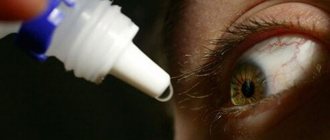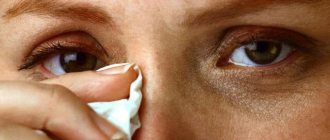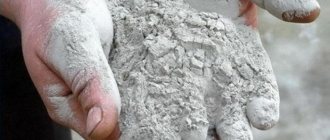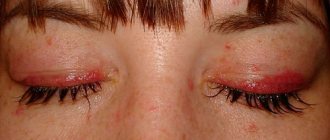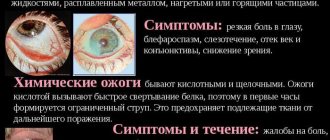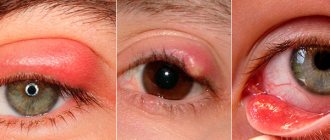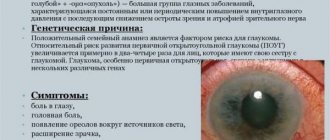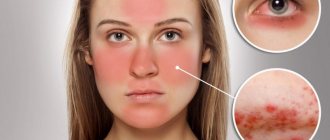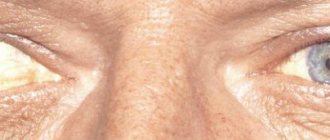Causes of damage
Acetic acid belongs to the carboxylic group and is considered one of its most typical representatives, exhibiting all the characteristic properties.
It is colorless, volatile, has a pungent odor, has a sour taste in low concentrations and easily dissolves in water. Upon contact with the skin and mucous surfaces, the acid destroys their cells, “burning” water out of them, causing protein denaturation, resulting in tissue necrosis, and with prolonged exposure, deep and extremely severe injuries occur.
Unintentional burns from acetic acid occur:
- in case of careless handling - for example, opening the cork with hands without gloves or, which is strictly prohibited, with teeth;
- if storage rules are violated: a loose lid, location on the edge of a shelf, which increases the risk of accidentally touching, breaking the container and dousing the contents;
- if a bottle of acid is found by people who, due to their age, are not aware of what they are dealing with (children, old people). They may accidentally swallow vinegar essence, resulting in severe burns to the esophagus and larynx.
What are the dangers of acetic acid?
Vinegar is a carboxylic acid. It is colorless and has a pungent odor. If the concentration is low - sour taste. When it gets on the skin or mucous membrane, it destroys proteins and soft tissue cells. Necrosis, that is, cell death, occurs instantly.
The reaction is characterized by the release of water. The degree of chemical burn to tissue encountered by this caustic substance depends on the concentration. The most severe vinegar burn can be obtained from vinegar essence, the concentration of which exceeds 30%.
A weak solution will take some time. If acetic acid gets on clothing and the victim does not notice it immediately, the resulting burn can be severe. Every minute matters.
First aid: what to do?
As soon as the acid gets on the mucous membranes, it is necessary to rinse the eye with cool running water. The duration of the procedure is 15-20 minutes. Since a quick wash will not completely remove the remaining reagent. If vinegar gets into a small child's eyes, you can fill a syringe with water and inject it directly into the eyeball. The colder the liquid, the stronger the analgesic effect. Afterwards, washing with a weak soda solution at a concentration of 1 tsp is indicated. for 1 glass. It is also recommended to fill a large container with cool water and put your face in it. You need to keep your eyes open. The procedure should be repeated 3-4 times or until the severe burning sensation disappears.
The doctor selects medications for the patient for a course of therapy.
An ophthalmologist may prescribe the following medications presented in the table:
| Name | Type of drug | Number of doses per day, times |
| "Cyclomed" | Ointment | 1 |
| "Hydrocortisol" | ||
| "Oftan Dexamethasone" | Drops | 3 |
| "Balarpan" | 5 | |
| "Levomycetin" | ||
| "Tsipromed" | 3 | |
| "Albucid" | 4 | |
| "Interferon" | 3 | |
| "Selcoseryl" | 5 |
Rubbing the eye with your hands or a towel is prohibited, so as not to cause additional infection of the mucous membranes.
You should not take medications unless prescribed by a doctor, as dosages vary depending on symptoms and physical parameters. Also, children should not be given Albucid 30%, because it will cause worsening retinal burns and increase redness. Immediately after injury, ointments should not be used. They are applied to the eyelids before bed to calm the inflammatory process. After the first symptoms have resolved, you can also apply a cool compress to your eyes to reduce swelling and relieve pain. Among folk remedies, a cool decoction of chamomile and calendula is recommended, which should be used to wash the eyes for 2-3 days.
Symptoms
The degree of damage depends on the concentration of the substance. A weak solution can cause harm only with prolonged exposure and appear after some time, while the essence instantly corrodes soft tissue upon contact with them.
You can understand that a person has received such a burn by the signs described below.
When in contact with high concentrations of acetic acid, the affected area becomes whitish, then turns gray due to cell death. A scabby, dry crust with clear boundaries forms on the skin. The victim experiences a strong painful burning sensation. The area around the burn may become red and swollen. After deep damage, scars form on the skin.
If concentrated vinegar gets into the esophagus, severe pain and burning will be obvious symptoms. The tissues of the mucous surface are instantly deformed. The victim has difficulty swallowing and speaking, a feeling of nausea appears, vomiting, chest spasms may occur, the temperature rises and the heart rhythm is lost. In this case, the mucous membranes swell greatly and the person may experience a lack of air and suffocation.
In the stomach, vinegar begins to interact with the hydrochloric acid contained in it. At high concentrations of the substance, their reaction becomes fatal to the patient.
If the acid has not been swallowed, only the oral cavity is affected: the papillae on the tongue are burned, taste buds lose sensitivity, soft tissues swell, a burning sensation appears, and the temperature rises.
If vinegar gets into your eyes, the same thing happens. If the acid is concentrated, it will corrode the cornea, and the person will lose vision without the possibility of restoration. The victim experiences severe pain, cannot be in the light (photophobia develops), and tearing appears.
Main features
Since vinegar belongs to the group of organic acids, injuries are commonly called chemical burns. Aqueous solutions of a substance with a concentration of more than 30% are considered dangerous to the body.
Symptoms of external damage from the solution appear immediately after contact with the skin. A crust appears on the area, hard and dry to the touch, with a clear, limited line in the area where the healthy cover begins.
Acetic acid burns on the skin are often superficial, but dirty white spots remain on the body. After the injury, the victim feels a bright, severe pain and burning sensation.
If the injury has affected the mucous membranes of the esophagus and pharynx, then the problems here are much more serious, since the destructive effect of the substance is enhanced by the hydrochloric acid present in this area of the body.
The effect of acid on the skin
Symptoms of a burn to the esophagus
There are many nerve endings in the tissues of the internal organs, therefore, when a burn of the esophagus occurs, the victim develops unbearable pain, felt behind the chest, in the cervical region, and in the upper abdomen. In addition, traces of injury and swelling are observed in the mouth and lips. As a result, the vocal cords are damaged from exposure to chemicals, and the voice becomes hoarse.
Due to the pathology, the tissues of the esophagus immediately swell, the lumen becomes blocked, and the victim faces the problem of normal swallowing.
The following symptoms also occur:
- vomiting, nausea;
- temperature increase to high levels;
- strong secretion of saliva.
The severity of this injury depends on many factors.
- Solution concentration.
- The time that a patient spends without proper medical treatment.
The longer the liquid acts on the mucous membranes, the more the tissues are destroyed, and this disease appears.
| Burn stages | Symptoms |
| 1 | Shock state of toxic course. Further signs of intoxication develop. |
| 2 | Toxemia occurs - overflow of blood in the vessels of the circulatory system and acute toxic psychosis. |
| 3 | Gastritis, pancreatitis, and peritonitis appear. |
| 4 | Burn asthenia is an imbalance of electrolytes and protein. |
Internal burn of the esophagus
Signs of acid eye damage
How severe the damage to the visual system will be will depend on the solution that led to the burn. Acid is less harmful than alkalis. Upon contact with acid, proteins fold and a cortical layer appears. Thanks to this, the substance does not penetrate into the eye.
The presence of severity of destruction also depends on the concentration of the solution. When affected by table vinegar, only a burning sensation occurs, and the concentrated essence will instantly melt the cornea of the eye. The patient loses vision irrevocably, since at stages 3 and 4 corneal clouding cannot be cured.
Eye burns
Acid vapor damage
Sometimes intoxication with vinegar vapor can occur. Then the victim develops a cough, runny nose, and tears flow. In rare cases, general poisoning of the body occurs. Chemical damage to the lungs can occur due to inhalation of concentrated vapors of the substance.
First aid for injuries to different parts of the body
If you neglect the rules for handling acids and caustic solutions, you can get burned by vinegar. They are usually divided into 2 types:
- Internal - the effect of the solution on the larynx, stomach, esophagus. Contact is dangerous because acetic acid that enters the stomach instantly reacts with hydrochloric acid from the stomach. Even a small volume and low concentration are dangerous due to the consequences of gastrointestinal disorders.
- External - affects the skin or mucous membranes. Prolonged contact with the active components of the acid causes severe damage. Moreover, the higher the concentration of the solution (5%, 10%, 70%), the more severe the consequences will be. If the wound is large, then you should not put off visiting a doctor.
Regardless of the type of injury received, there are 4 degrees of severity. Only a doctor can determine them:
- the first one is the easiest. It is characterized by redness of the skin, soreness, and slight swelling. Complete healing occurs in 3–4 days. It should be noted that there will be no trace left on the body that could remind of the unpleasant incident.
- in the second degree, 2 layers of the epidermis are affected: the stratum corneum and the germ layer. The wound, as in the first case, does not leave behind scars, but regeneration of skin cells and healing will take about 2-3 weeks.
- the third and fourth degrees are characterized by the formation of black or brown crusts and scabs. At stage 3, the skin is affected down to the sweat, sebaceous glands, and blood vessels.
Grade 4 injury reaches the fatty tissue. You can get such a serious wound with vinegar of the highest concentration.
If you realize you have been burned by acetic acid, remain calm. This will allow you to carefully plan all actions and avoid serious consequences. First of all, it is necessary to stop the contact of the acid with the skin or mucous membranes. The first aid technique depends on the affected area.
This type of injury can be considered the most dangerous to life and health. 50 ml of 70% vinegar essence is considered a lethal dose for an adult. For a child, this dose is reduced several times, which is why it is recommended to hide the acid from children and the elderly.
The victim must be immediately taken to the nearest medical facility. First aid consists of taking a soda solution and drinking plenty of warm boiled water. The larger the volume of water the esophagus and stomach are washed, the lower the risk of complications.
In most cases, the patient will be offered hospital treatment. You will have to stop eating for the next few days.
Receiving such an injury in a domestic environment is almost impossible. A burn to the respiratory tract can be caused by prolonged inhalation of vapors or by accidental inhalation of vapors from a 70% solution. Not only the upper sections are damaged, but sometimes even the bronchi.
Providing first aid consists of washing the accessible parts as much as possible and ingesting a bicarbonate solution. For an adult, the dosage is 0.5 liters. You can also neutralize the effect of vapors with a soda solution.
Treatment can only be provided by medical professionals. The victim is picked up by an ambulance and taken to the nearest hospital. The patient is prescribed:
- antihistamines;
- painkillers;
- moisturizing inhalations;
- antibiotics to prevent the development of pathogenic microflora.
Treatment is usually long-term and can last for several months.
When acid enters the oral cavity, it immediately reacts. The degree and complexity of the injury depends on the timeliness of preventive measures. It is necessary to rinse the affected area thoroughly and in large quantities.
It is acceptable to prepare an alkaline solution (water with soda). The duration of the manipulations is at least 15–20 minutes. At this time, you need to call an ambulance so that doctors can assess the extent of the damage, the need for surgical intervention, and hospital treatment.
Burn of the larynx
The victim must immediately begin gargling and gastric lavage with an alkaline solution. Drinking plenty of fluids is recommended.
Further, the victims are prescribed antihistamines, medications to stabilize the heart rhythm, and painkillers.
Skin burn
Skin burns from vinegar are a common injury in everyday life. If acid gets on the skin, it should be thoroughly washed off the affected area under running water. To neutralize the residual effect of the acid, the burn site is treated with alkali.
To do this, use regular soap or baking soda. The treated area is washed again with water, and then an anti-inflammatory ointment and a sterile bandage are applied.
If drops of acetic acid get on clothing, the burn does not appear immediately. Itching and burning can be felt after two hours. The first aid action plan remains the same. It is important not to forget to change your clothes.
Burn of the mucous membrane of the eyes
Acid that gets into the eyes entails the most unexpected, unpleasant consequences. The victim feels acute pain and burning. The burn is accompanied by profuse lacrimation. Scars may remain on the surface of the mucosa, which has a detrimental effect on visual acuity. The damage can be so extensive and severe that the person loses vision.
Help lies in long-term washing. It should be noted that the eyes need to be opened in the water in order to quickly wash away any remaining caustic liquid. The duration of rinsing is about 20–30 minutes.
For convenience, you can replace washing with a bath of water, where the victim lowers his face and opens his eyes. When first aid has been provided, you need to visit an ophthalmologist. The specialist will prescribe restorative eye drops and a disinfectant healing gel.
What to do if vinegar gets on your skin? If possible, it is better to ask someone who is nearby at the time to help. If the epidermis is burned, you should immediately rinse the affected area thoroughly with cool water. Next, you should treat the injured area in one of the following ways:
- Soap solution;
- Soda solution.
After this, the burn is again washed with plenty of water and a damp compress is applied to it, which will reduce the concentration of acid if it still remains on the skin. The pain should subside a little, and then all that remains is to perform several sequential actions:
- Treat the wound with an antiseptic, cream or other special preparation for burns, if you have something like that on hand;
- Apply a loose bandage;
- If the case is really serious, then it is better to call an ambulance, otherwise there will be nothing left to do but go to the hospital so that the doctor prescribes treatment.
What to do when vinegar or essence gets on the mucous membrane? Acid, for example, can get into your eyes when opening a bottle of vinegar or handling it carelessly. In this case, the eyes are also immediately washed for a long time, first with clean water, then with a weak soda solution, and again with water. The colder the water, the more beneficial it will be for pain relief from the burn.
Acetic acid can enter the digestive tract in one way or another, and the first thing to do in this case is to call an ambulance. You should immediately begin serious rinsing of the intestines, using for this purpose alternately clean water and a weak soda solution. In this case, you can’t even think about any independent treatment! Only professional help will prevent serious consequences.
To avoid a burn from vinegar and its consequences, it is better to play it safe in advance and keep this acid tightly closed and away from children. If you are unlucky enough to be doused with acetic acid or swallow it, then you need to act decisively and not be afraid to seek help from specialists in order to get the necessary treatment. The consequences of a burn are the only thing you need to fear in this situation.
Tuberculous lupus: causes and factors in the development of the disease, its types, routes of infection, signs of pathology, diagnosis and treatment, preventive measures
Gneiss: causes of development, symptoms and features of the course, diagnosis, treatment and preventive measures
Pyoderma: causes and signs of the disease, classification, diagnostic methods, treatment and prevention
Panaritium - causes and signs of the disease, its signs and types, methods of treatment and prevention
Pityriasis versicolor: causes and signs of the disease, diagnostic methods and treatment methods
Pityriasis rosea or roseola rosea: causes, signs, diagnosis and treatment
Lichen planus: causes and types of disease, methods of diagnosis and treatment, prognosis
Ecthyma: causes and signs of the disease, risk flus, diagnosis and treatment
Melanoma: causes of neoplasm, classification, diagnosis and treatment
Rhinophyma: features and signs of the disease, its causes and forms, diagnosis and treatment
‹›
Symptoms of a vinegar burn
When acetic acid comes into contact with the skin, a white spot first appears, which quickly darkens and turns gray. In this case, the injury site hurts quite a lot, and a burning sensation is felt in the tissues.
If vinegar gets into the esophagus, the situation is much more serious, since its effect is enhanced by hydrochloric acid. The complexity of such a burn depends on the concentration of vinegar, as well as on the time of its exposure to the mucous membrane.
Combustiologists distinguish certain stages that occur during burn disease:
- First, a person experiences toxic shock, after which the first signs of intoxication of the body appear.
- Toxemia develops, which is characterized by skin hyperemia and acute toxic psychosis.
- Various diseases begin to manifest themselves, including pneumonia, gastritis, peritonitis, pancreatitis.
- Burn asthenia (protein and electrolyte balances are disturbed, the weight of the victim is greatly reduced).
Face burn with vinegar
If acetic acid gets on the skin of the face, it is necessary to rinse the epidermis with cool tap water as quickly as possible. It is best to ask someone close to you to help you (if such a possibility exists). After the wound has been washed well, you need to treat it with soda or soap solution. Immediately wash the burn area again and apply a (wet) compress on top. This way you can reduce the concentration of that acid that still remains on your facial skin.
As soon as the intensity of pain decreases slightly, you need to:
- Apply an antiseptic (cream or gel) to the damaged area, which you can find in your home medicine cabinet.
- Apply a bandage on top of the wound.
Remember, if the burn is very severe, it is best to call an ambulance immediately.
Burn of the esophagus with vinegar
In some cases, acetic acid enters the esophagus. The first thing to do if this happens is to call an emergency doctor.
In the hospital, the patient’s stomach is immediately rinsed using a special probe, first using ordinary drinking water and a special soda solution (5% sodium bicarbonate solution), and forced diuresis is performed. Remember that such a chemical burn is too serious, so do not self-medicate under any circumstances.
[5]
Eye burn with vinegar
Sometimes acid can get into the mucous membrane of your eyes, for example, when you open a bottle of vinegar. To provide first aid to the victim, you must immediately rinse your eyes with clean running water. This process needs to be extended over a fairly long period of time. Then replace the water with a weak solution of soda (1 teaspoon per 250 ml or a regular glass of water), and then rinse again with water. The lower the temperature of the water, the faster the analgesic effect from its use will occur. After this, consult a doctor immediately.
[6]
Throat burn with vinegar
When the throat is burned with vinegar, the following symptoms appear:
- Excruciating and quite intense pain when swallowing.
- Burning and pain in the larynx, in the Adam's apple area.
- Increased salivation.
- Nausea with severe vomiting.
- Body temperature can rise to 38 degrees.
- The oral cavity swells.
- The lymph nodes swell and begin to hurt.
- When vomiting, there is a characteristic vinegar smell.
If a vinegar burn to the throat is severe, it can lead to suffocation or collapse.
First aid, which is usually provided at home, is the most important step towards recovery. First of all, you need to try to neutralize the acetic acid that gets on the mucous membrane of the throat. Prepare a weak soda solution and gargle well with it (you can replace it with a weak solution of burnt magnesia). Immediately after this, call an ambulance, since in case of a chemical burn to the throat, gastric lavage is an important step.
Vinegar burn on a child
Children often play with illegal substances. Therefore, even if you hid the acetic acid well, your child may find it and accidentally pour it on himself. In such a case, it is important not to panic, but to immediately strip the baby naked and bathe him in fairly warm water with regular soap. Remember that you cannot rinse only the limbs without removing clothes, as drops of vinegar may remain on the fabric, which will cause chemical burns on the body.
Complications and consequences
The consequences of a vinegar burn on the skin are scars. If the eyes are injured, then, depending on the extent of the damage, the outcome may be the development of cataracts, partial or complete loss of vision.
If a person swallows an aggressive substance, then not only the walls of the esophagus are burned, but also other internal organs involved in the process of digestion and elimination of toxins: liver, kidneys, intestines, pancreas, gall bladder, urinary system. In addition, the acid is absorbed into the blood and the body experiences toxic shock.
The consequence of a burn is the development of diseases such as:
- gastritis;
- stomach ulcer;
- inflammation of the abdominal cavity, pancreas;
- pneumonia;
- renal and liver failure.
A person loses significant weight, and the body’s immune defense decreases. In this case, the victim cannot eat fully, as he must constantly follow a strict diet in order to spare the stomach and digestive system.
With serious extensive damage to internal organs, a person dies.
What complications can there be?
Vinegar causes varying degrees of burns to the cornea of the eyes.
Although acid is less dangerous than alkali, exposure to the eye can lead to complete loss of vision. In severe cases, the acid completely burns through the cornea to the sclera and causes the formation of a white spot. Another complication is complete or partial clouding of the eye lens, which will also lead to irreversible pathological processes that can lead to blindness in the affected eye. Therefore, even if the unpleasant first symptoms were managed to stop, you should definitely consult an ophthalmologist. The destructive influence can occur unnoticed. Another possible cause of discomfort in the eye, which does not go away for 2-3 days, is infection of the mucous membranes. In this case, the ophthalmologist may prescribe a course of antibiotics.
First aid rules
If acid gets on clothing, it must be removed immediately, even if the strength of the composition is low. With prolonged contact with the skin, table vinegar also injures the surface.
The affected area should be washed with plenty of running water for at least 15 minutes. This will help relieve pain and clean the surface. Then, to stop the effects of the acid, apply a weak solution of soda to the burn (1 teaspoon per glass of water) or wash it several times with laundry soap.
In case of any injury, it is necessary to call an ambulance as quickly as possible or take the victim to the hospital.
Healing procedures
For a chemical burn to the eye, first aid involves a set of certain actions. It must be provided on an emergency basis. It’s good if there is a person nearby with a medical education or basic knowledge in this area. But even an ordinary person can help.
First aid
So, what to do for chemical eye burns? There are several stages of emergency assistance:
First, it is urgent to rinse the affected eye (no later than 30 minutes after contact with the chemical). To do this, use a physiological solution of sodium chloride 0.9% (table salt) or a weak solution of potassium permanganate (potassium permanganate). They have antiseptic properties.
If nothing is available, rinse the eyes with plain water from the inner corner of the eye to the outer corner to avoid chemicals getting into the healthy eye. If there are solid particles of the chemical (lime) in the eye, they should be removed with a dry cotton swab before rinsing.
- When it is known exactly what substance caused the burns, it can be neutralized. In case of an alkaline burn, the eyes should be rinsed with water and vinegar or 2% boric acid. A few drops per 500 ml of water is enough. If the burn is caused by acid, you need to treat your eyes with a weak soda solution.
- To avoid infection, antiseptic eye drops are dripped into the eye. A solution of furatsilin or sodium sulfacil is suitable for this purpose.
After all these manipulations, you should cover the affected area with a clean bandage, give the patient a sedative and send him to the hospital, where appropriate treatment will be carried out.
It depends on the severity of damage to the eyeball and the presence of concomitant conditions (inflammation, pain shock and others).
Therapy
If a small area of skin in an adult is injured, then first aid and treatment can be carried out at home.
If the victim is a child or a mucosal burn occurs, then consultation with a specialist is necessary.
Treatment consists of timely provision of first aid, elimination of aggressive acid from the surface of the skin or mucous membrane. Next, wound healing gels or ointments are applied to the affected area. A sterile bandage is applied on top. It should not put pressure on the injured area.
It is also important to do dressings in a timely manner. If blisters appear on the wound, do not open them yourself. Entrust this activity to a traumatologist or surgeon. He will carry out all manipulations under local anesthesia followed by application of an antiseptic solution.
Medicines
Self-prescribing medications is unacceptable. Only a doctor can determine a drug treatment plan.
Drugs that can be used for chemical burns can be divided into 3 main groups:
- Antiseptics for disinfection and permanent treatment of wounds. They prevent the entry of pathogens.
- Painkillers, cooling, anti-burn creams, gels.
- Antibacterial ones do not allow the wound to fester.
If the burn is external and the lesion is not severe, then independent use of Levomekol, Bepanten, Panthenol is acceptable.
If the burns are deep, the doctor may prescribe local antibiotics and anti-inflammatory drugs. Baneocin powder is very popular, it dries the top layer, protects against the penetration of pathogenic bacteria, and has wound-healing properties.
Baneocin is a powder that dries the top layer well, protects against the penetration of pathogenic bacteria, and has wound-healing properties.
The antibiotic Cifran works throughout the body as an anti-inflammatory drug, but before taking it, you must consult a doctor.
Folk remedies
If medications are not at hand, and the nearest pharmacy is far away, then traditional methods are often used. Among all the known methods, the most popular for acetic acid burns are the following:
- Sea buckthorn oil. They treat the wound until complete healing.
- Butter and beeswax mixed in a 3:1 ratio. To prepare, both ingredients must be melted in a water bath and mixed thoroughly. The cooled mixture is applied to the affected area and a bandage is applied on top.
- Crushed aloe stem. To prepare it, you need to grind the aloedo leaf into a mushy state and apply it to the skin. A bandage is made from a sterile bandage on top. During the day it can be removed, and the wound is washed with aloe juice.
- Fresh potatoes. Peel the root vegetable and grate it. The paste is applied to the wound and secured with a sterile bandage. It is also permissible to apply a cut of a tuber - the main wound-healing component is the secreted juice.
- You can make wet compresses from strong tea leaves. It is important to change them periodically to cool and relieve acute pain.
- A decoction of chamomile, calendula, oak bark, and St. John's wort will relieve swelling and eliminate pain. To prepare, you need to mix all the ingredients in equal proportions. One tablespoon of herbal mixture will require one liter of boiling water. The decoction is infused for 30 minutes.
A doctor prescribes a treatment regimen for a skin burn. He selects medications depending on the clinical picture of the lesion.
If the therapy takes place in a hospital setting, the patient is given special solutions to purify the blood, neutralize the acid and remove its breakdown products.
For treatment at home, various ointments, gels, sprays for treating the wound surface, means to accelerate tissue regeneration, painkillers, anti-inflammatory tablets, and antibiotics are prescribed.
Medicines
At the injury healing stage, the following is prescribed for external use:
- Bepanten;
- Solcoseryl;
- Radevit;
- Levomekol;
- Rescuer;
- Vishnevsky;
- Dermazin.
Wounds should be smeared regularly, according to the instructions of a particular drug. If necessary, before application, disinfect with antiseptic agents - Miramistin, Chlorhexidine, Furacilin.
Folk remedies
The use of any folk remedies is permissible only at the stage of treating a burn, but not when providing first aid. Before using them, you should consult your doctor.
Among the most effective folk methods are the following:
- Use sea buckthorn oil to lubricate the burn. Carry out the treatment at least 3 times a day.
- Brew oatmeal with a small amount of boiling water to form a liquid porridge-like mass. Let it brew for 20-30 minutes. Drain off excess water. Squeeze out the cereal and use the released mucus to wipe the injured area.
- Grate the potatoes on a fine grater. Squeeze. Apply the paste as a compress for 30 minutes.
- Apply fresh juice from aloe leaf in a thin layer several times a day to the affected area.
- Prepare a decoction of oak bark and coltsfoot, taken in equal proportions. Pour 1 tablespoon of raw material into 250 ml of boiling water, leave for 20 minutes, strain and cool at room temperature. Soak gauze in the broth and apply as a compress for half an hour, 2-3 times a day.
Surgery is required for extensive and deep injuries. Often there is a need for skin grafting or plastic surgery to remove scars after wound healing.
What you should absolutely not do if you have a vinegar burn
The principles of providing first aid to a child with an acid burn do not differ from those recommended for an adult. At the same time, it is important to quickly identify the source of injury so that further actions do not aggravate the situation.
For any degree of damage to the baby, you must call an ambulance. If possible, doctors should show a container of liquid that the child drank or spilled. Having information about the concentration of the substance and its composition, it will be easier for doctors to select the necessary remedy to neutralize the acid. This will significantly speed up the process of providing assistance.
Every person's first aid kit probably contains a variety of antiseptics and medications for treating wounds. The most popular include iodine, brilliant green, potassium permanganate, and hydrogen peroxide. It is strictly forbidden to treat wounds with vinegar burns with these solutions. Not only will they not produce results, but they may even make the situation worse.
Badger and bear fat have long been popular among adherents of alternative medicine. But treating wounds with fat is also prohibited. They create an invisible film. Under the dense layer, an ideal environment is formed for the development and reproduction of pathogenic microflora. After a few days of such self-medication, the wound may begin to fester.
An adult is responsible for his body and health independently, but if we are talking about a child, it is better to spend a couple of hours consulting a specialist who will competently plan treatment.
